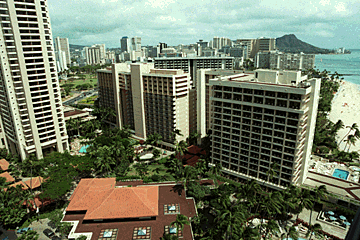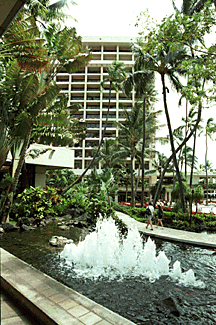
Planners point to the Hilton Hawaiian Village as a model of how to develop property with open space. It has 2,542 rooms with more on the way, but ample pedestrian areas keep things on a human scale.
Photos by Craig Kojima, Star-Bulletin

Planners point to the Hilton Hawaiian Village as a model of how to develop property with open space. It has 2,542 rooms with more on the way, but ample pedestrian areas keep things on a human scale.
Photos by Craig Kojima, Star-Bulletin
At 2,542 hotel rooms and 400 more coming with its new Kalia Tower, the 20-acre complex has as high a density as any other location in Waikiki.
But Hilton officials and visitors alike, as do planning experts, say most of that density goes unnoticed because half of its pedestrian level is defined as open space.
That's what city officials want from developers in the rest of Waikiki.
Peter Schall, Hilton Hawaiian Village managing director, said the decade-old master plan for the complex meant demolishing several smaller buildings, including small hotels, "just to make space for the openness."
Outdoor dining facilities, lei stands and other accommodations that normally don't count toward density (defined as floor-to-area ratio, or FAR) would be allowed, even encouraged, under the Planning Department's Waikiki Planning and Program Guide.
The guide accompanies the mayor's proposed amendments to the Waikiki Special District, which looks at trading more allowable density for open space.
Schall said the emphasis on pedestrian facilities "adds to the atmosphere. The outdoor dining, the park benches to sit and enjoy the environment."
 A waterfall, artwork and plants intermingle with the shops and restaurants of the Hilton's Rainbow Bazaar commercial area.
A waterfall, artwork and plants intermingle with the shops and restaurants of the Hilton's Rainbow Bazaar commercial area.
"You don't pay much attention to the high-rise buildings because everything is built on a human scale - it's eye level," Schall said.
Christina Kemmer, executive director of the city's Office of Waikiki Development, said she envisions "more greenery at the ground level, a more park-like, Hawaiian atmosphere, cultural activities, outdoor dining and lei stands" in redeveloped Waikiki.
But planner Donald Bremner said the 10 sites identified by the city Land Utilization Department as potential growth spots don't have 20 acres to work with - as Schall did when he developed the Hilton's master plan.
"You're not going to find too many opportunities to repeat that," said Bremner, who helped develop the city's 20-year-old Waikiki Special District ordinance.